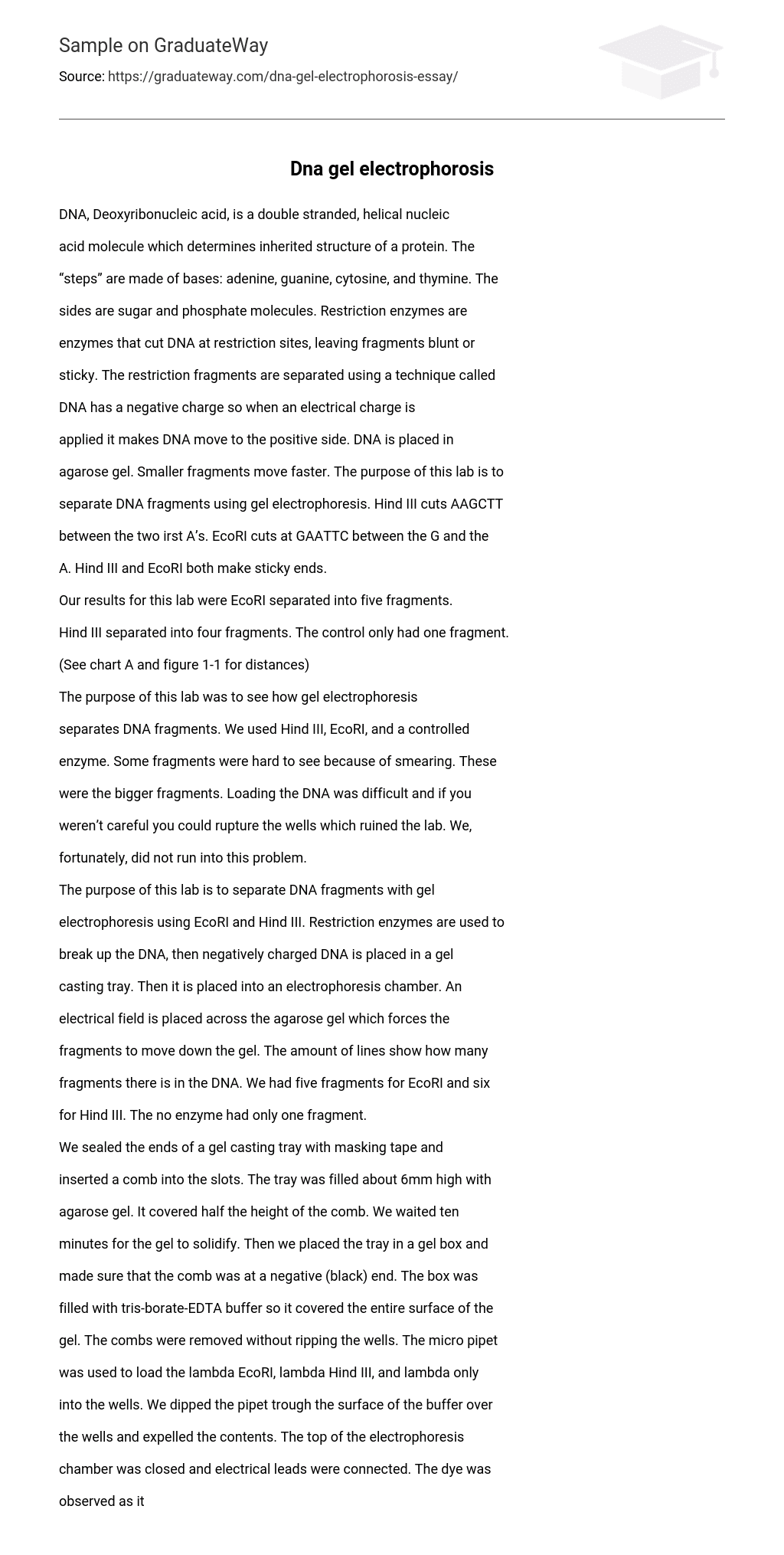DNA, Deoxyribonucleic acid, is a double stranded, helical nucleic acid molecule which determines inherited structure of a protein. The “steps” are made of bases: adenine, guanine, cytosine, and thymine. The sides are sugar and phosphate molecules. Restriction enzymes are enzymes that cut DNA at restriction sites, leaving fragments blunt or sticky.
The restriction fragments are separated using a technique called DNA has a negative charge so when an electrical charge is applied it makes DNA move to the positive side. DNA is placed in agarose gel. Smaller fragments move faster. The purpose of this lab is to separate DNA fragments using gel electrophoresis. Hind III cuts AAGCTT between the two irst A’s. EcoRI cuts at GAATTC between the G and the A. Hind III and EcoRI both make sticky ends.
Our results for this lab were EcoRI separated into five fragments. Hind III separated into four fragments. The control only had one fragment. (See chart A and figure 1-1 for distances) The purpose of this lab was to see how gel electrophoresis separates DNA fragments. We used Hind III, EcoRI, and a controlled enzyme. Some fragments were hard to see because of smearing. These were the bigger fragments. Loading the DNA was difficult and if you weren’t careful you could rupture the wells which ruined the lab. We, fortunately, did not run into this problem.
The purpose of this lab is to separate DNA fragments with gel electrophoresis using EcoRI and Hind III. Restriction enzymes are used to break up the DNA, then negatively charged DNA is placed in a gel casting tray. Then it is placed into an electrophoresis chamber. An electrical field is placed across the agarose gel which forces the fragments to move down the gel. The amount of lines show how many fragments there is in the DNA. We had five fragments for EcoRI and six for Hind III.
The no enzyme had only one fragment. We sealed the ends of a gel casting tray with masking tape and inserted a comb into the slots. The tray was filled about 6mm high with agarose gel. It covered half the height of the comb. We waited ten minutes for the gel to solidify. Then we placed the tray in a gel box and made sure that the comb was at a negative (black) end. The box was filled with tris-borate-EDTA buffer so it covered the entire surface of the gel. The combs were removed without ripping the wells.
The micro pipet was used to load the lambda EcoRI, lambda Hind III, and lambda only into the wells. We dipped the pipet trough the surface of the buffer over the wells and expelled the contents. The top of the electrophoresis chamber was closed and electrical leads were connected. The dye was observed as it moved shortly after the power supply was turned on. The power supply was turned off after the bands migrated near the end of the gel and the top of the electrophoresis chamber was removed. We removed the gel from the gel casting tray and examined it under a light box and compared it to the ideal gel.
References
- Restriction Enzymes: Cleavage of DNA lab University of Illinois. (1999). Experiment 2 Gel Electrophoresis of DNA. In Molecular Biology Cyberlab, online: Http://www.life.uluc.edu/molbio/geldigest/electro.html





